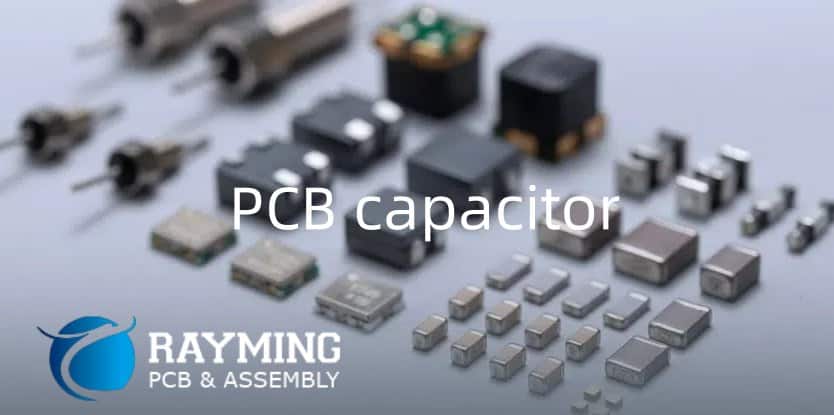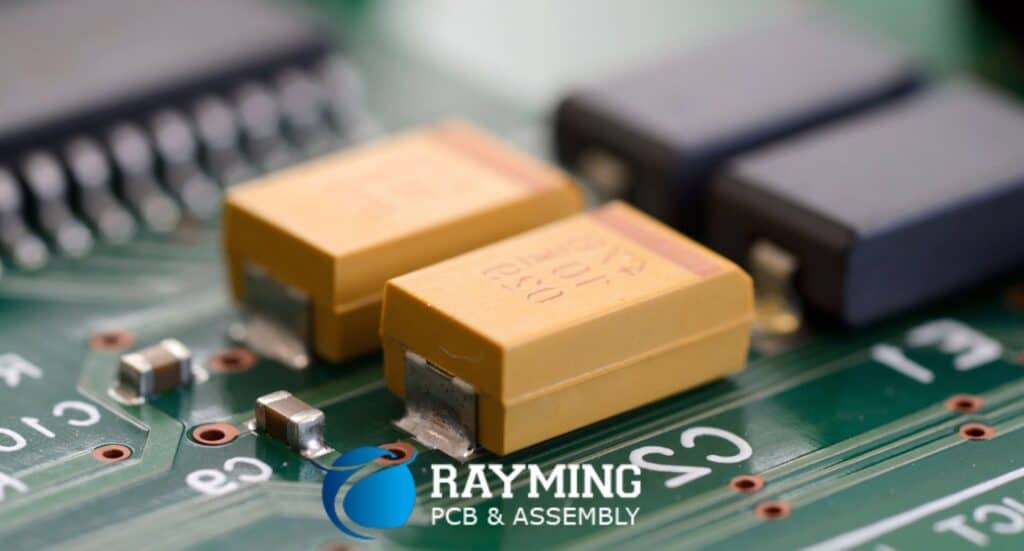In the realm of printed circuit board (PCB) design and electronics, capacitors play a crucial role in various applications, including power supply filtering, signal decoupling, and timing circuits. Among the various types of capacitors, PCB capacitors, also known as surface-mount capacitors or chip capacitors, have become an indispensable component in modern electronic devices and systems.
Introduction
PCB capacitors are compact, surface-mount components designed to be mounted directly onto printed circuit boards during the assembly process. These capacitors are available in a wide range of capacitance values, voltage ratings, and package sizes, making them suitable for a variety of applications and PCB designs.
What are PCB Capacitors?

PCB capacitors are passive electronic components that store electrical energy in the form of an electrostatic field. They consist of two conductive plates separated by an insulating material, known as the dielectric. When a voltage is applied across the capacitor, electric charges accumulate on the conductive plates, creating an electrical field within the dielectric material.
PCB capacitors are classified based on their dielectric material, which determines their electrical characteristics and performance. The most common types of PCB capacitors include:
- Ceramic Capacitors: These capacitors use ceramic materials, such as barium titanate or lead zirconate titanate, as the dielectric. Ceramic capacitors are widely used in various applications due to their high capacitance density, low cost, and broad range of capacitance values.
- Tantalum Capacitors: Tantalum capacitors utilize a tantalum oxide dielectric, which provides high capacitance in a small package size. These capacitors are known for their low equivalent series resistance (ESR) and are commonly used in power supply filtering and decoupling applications.
- Electrolytic Capacitors: Electrolytic capacitors employ an electrolytic solution as the dielectric material, typically aluminum or tantalum oxide. They are characterized by their high capacitance values and are often used in power supply filtering and energy storage applications.
- Film Capacitors: These capacitors use dielectric films, such as polyester, polypropylene, or polycarbonate, as the insulating material. Film capacitors are known for their excellent stability, low dielectric losses, and high voltage ratings, making them suitable for applications requiring precision and reliability.
PCB capacitors are available in various package styles and sizes, ranging from tiny 0201 or 0402 packages to larger case sizes like 1206 or 1210. The smaller packages are commonly used in high-density PCB designs, while larger packages may be preferred for higher voltage or capacitance requirements.
Applications of PCB Capacitors
PCB capacitors are essential components in a wide range of electronic circuits and devices, serving various functions:
- Power Supply Filtering: Capacitors are used in power supply circuits to filter and smooth out ripples and noise in the DC power supply, ensuring a stable and clean power source for electronic components.
- Decoupling and Bypass: PCB capacitors are employed as decoupling or bypass capacitors to provide local energy storage and filtering for integrated circuits (ICs) and other components, preventing noise and voltage fluctuations from affecting their performance.
- Timing Circuits: Capacitors are used in timing circuits, such as oscillators and timers, in combination with resistors to control the timing and frequency of signals.
- Signal Filtering and Coupling: Capacitors can be used to filter out unwanted frequencies or couple signals between different circuit stages, allowing for precise signal conditioning and processing.
- Energy Storage: In some applications, such as backup power supplies or energy harvesting systems, capacitors are used to store electrical energy for short-term power delivery or energy buffering.
- Tuning Circuits: In radio frequency (RF) and telecommunications applications, variable capacitors are employed for tuning circuits, allowing for frequency adjustment or impedance matching.
Selecting PCB Capacitors
When selecting PCB capacitors for a particular application, several factors must be considered to ensure optimal performance and reliability:
- Capacitance Value: The capacitance value is a critical parameter that determines the amount of charge the capacitor can store. It is essential to select the appropriate capacitance value based on the circuit requirements and design specifications.
- Voltage Rating: The voltage rating of a capacitor specifies the maximum voltage that can be applied across the capacitor without causing dielectric breakdown or damage. It is crucial to choose a capacitor with a voltage rating that exceeds the expected operating voltage in the circuit.
- Temperature Characteristics: The performance of capacitors can be affected by temperature variations. Different types of capacitors have varying temperature coefficients and operating temperature ranges, which need to be taken into account for the intended application.
- Equivalent Series Resistance (ESR): ESR is a measure of the internal resistance of a capacitor, which can affect its performance, particularly in high-frequency applications or power supply filtering. Lower ESR values are generally preferred for better performance.
- Ripple Current Rating: For capacitors used in power supply filtering or high-current applications, the ripple current rating is an important consideration. This rating specifies the maximum alternating current the capacitor can handle without overheating or degradation.
- Dielectric Material: The dielectric material used in the capacitor determines its electrical properties, such as capacitance stability, dissipation factor, and temperature characteristics. The choice of dielectric material depends on the specific application requirements.
- Package Size and Footprint: The physical dimensions and package style of the PCB capacitor must be compatible with the available space on the PCB and the assembly processes used.
- Cost and Availability: While performance and reliability are paramount, the cost and availability of PCB capacitors should also be considered, especially for high-volume production or applications with specific supply chain requirements.
PCB Capacitor Mounting and Assembly

PCB capacitors are typically surface-mounted components, requiring specialized assembly processes and techniques. The most common mounting methods for PCB capacitors include:
- Reflow Soldering: PCB capacitors are compatible with reflow soldering processes, where a solder paste is applied to the PCB pads, and the components are placed using pick-and-place machines. The assembly is then heated in a reflow oven, melting the solder and creating a permanent electrical and mechanical connection.
- Wave Soldering: Wave soldering is another common assembly method for PCB capacitors, particularly in through-hole applications or mixed-technology PCBs. The PCB assembly is passed over a wave of molten solder, allowing the capacitor leads or pads to be soldered to the board.
- Hand Soldering: In some cases, such as prototyping or rework, PCB capacitors may be hand-soldered onto the PCB using a soldering iron and solder wire.
Proper handling and assembly techniques are essential to ensure reliable solder joints and prevent damage to the capacitors during the assembly process.
Frequently Asked Questions (FAQs)
- Q: What is the difference between a PCB capacitor and a through-hole capacitor? A: PCB capacitors, also known as surface-mount capacitors or chip capacitors, are designed to be mounted directly on the surface of a printed circuit board using surface-mount technology (SMT). In contrast, through-hole capacitors have leads that are inserted into holes drilled in the PCB and soldered on the opposite side.
- Q: Can PCB capacitors be polarized or non-polarized? A: While most PCB capacitors, such as ceramic and film capacitors, are non-polarized, meaning they can be installed in either direction, electrolytic capacitors are polarized and must be installed with the correct polarity to avoid damage or failure.
- Q: How do I determine the appropriate capacitance value for my circuit? A: The capacitance value required for a specific application depends on various factors, such as the operating frequency, voltage ripple requirements, and the characteristics of other components in the circuit. Capacitor selection often involves calculations or simulations based on the circuit design specifications and performance requirements.
- Q: Can PCB capacitors be replaced or repaired? A: PCB capacitors are typically surface-mounted components, and replacing them can be challenging, especially in high-density PCB designs. In some cases, capacitors can be removed and replaced through specialized rework processes, but this may not be feasible or cost-effective in all situations. Prevention through proper design and assembly practices is generally preferable.
- Q: Are there any special considerations for using PCB capacitors in high-frequency or RF applications? A: In high-frequency or RF applications, the parasitic inductance and impedance characteristics of PCB capacitors become more significant. Special attention must be paid to factors such as package size, lead length, and capacitor placement to minimize unwanted effects and ensure optimal performance at these frequencies.
PCB capacitors are essential components in modern electronic devices and systems, serving various functions such as power supply filtering, decoupling, and timing circuits. With their compact size, surface-mount packaging, and diverse range of capacitance values and dielectric materials, PCB capacitors offer designers and engineers the flexibility to meet diverse design requirements. Proper selection, mounting, and assembly techniques are crucial to ensure reliable performance and longevity of these vital components in printed circuit board designs.



0 Comments